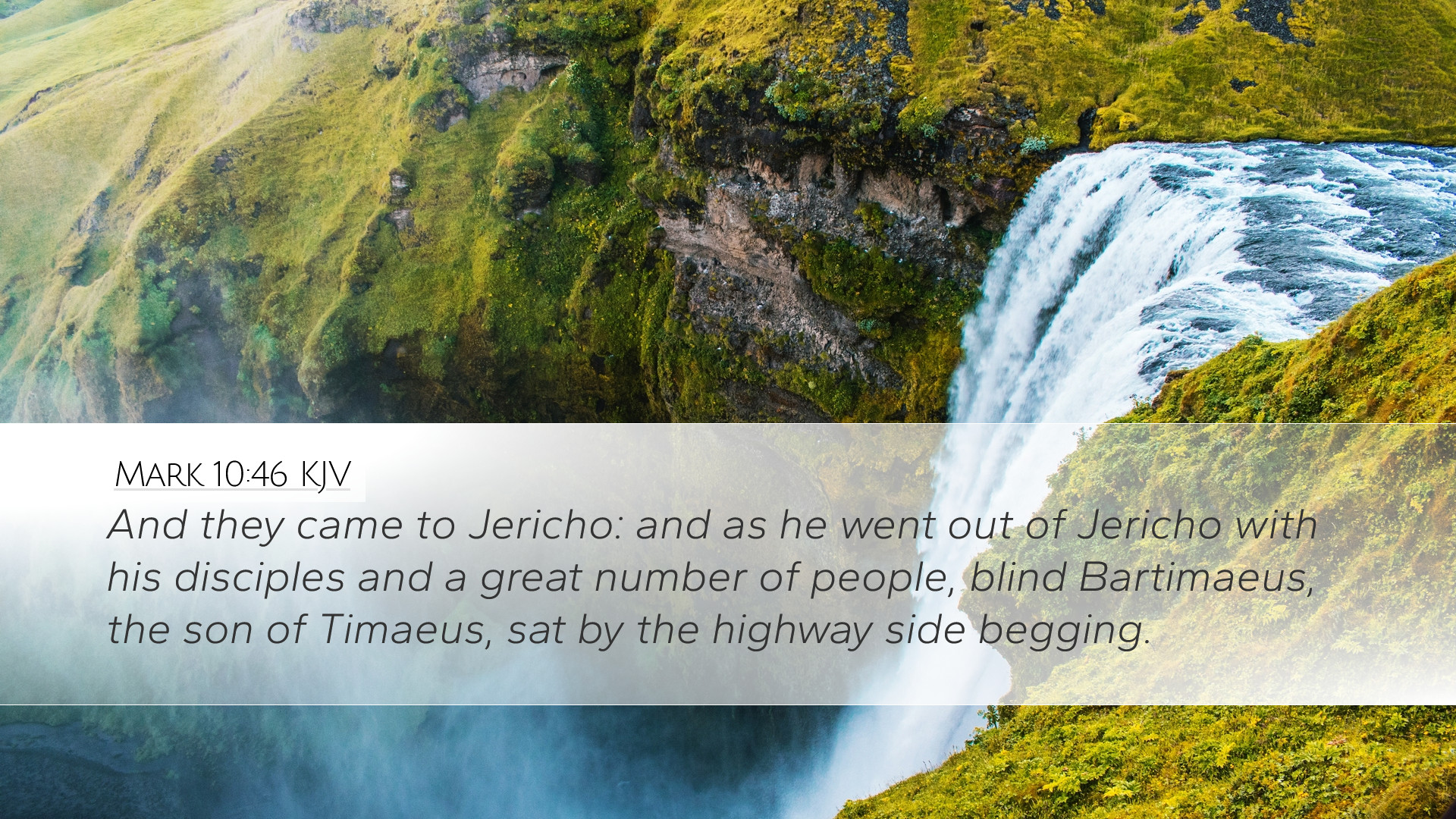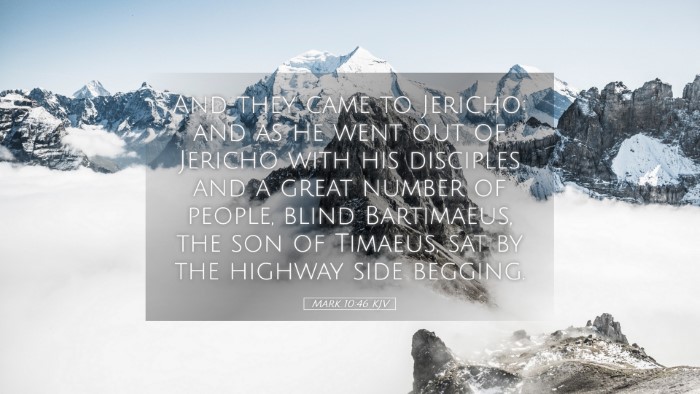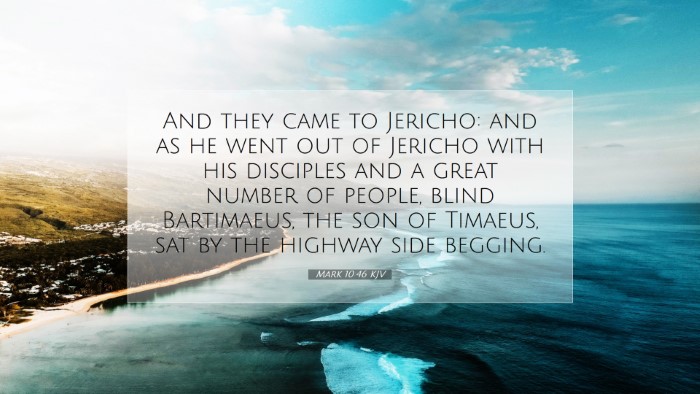Bible Commentary on Mark 10:46
Mark 10:46 states, "And they came to Jericho: and as he went out of Jericho with his disciples and a great number of people, blind Bartimaeus, the son of Timaeus, sat by the highway side begging." This brief narrative introduces one of the most poignant healing stories in the Gospels and provides rich theological and practical insights.
Contextual Background
The significance of Jericho should not be overlooked. This ancient city, known as the City of Palm Trees, had historical importance as the first city conquered by the Israelites upon entering the Promised Land (Joshua 6). Its geographical location also made it a focal point for travelers and pilgrims heading to Jerusalem. Thus, the setting is not only physical but carries historical and spiritual connotations.
The Character of Bartimaeus
Bartimaeus as a Symbol: Blind Bartimaeus is a figure who embodies physical and spiritual blindness. His name, which means “son of Timaeus,” is significant as it illustrates his known identity among the populace. His blindness represents a condition not only of the eyes but of the spirit, highlighting the need for divine illumination.
Desperation in Need: As Bartimaeus sat begging by the roadside, he epitomizes the desperation of those seeking help. His position denotes societal marginalization, and yet his cry for mercy reflects an earnest faith. In the biblical context, beggars often conveyed the urgency and need for divine intervention, making his response to Jesus particularly profound.
Spiritual Insights into the Text
The Approach to Christ: Bartimaeus’ approach to Jesus highlights important themes of faith and persistence. In the face of societal rebuff, he cried out with a loud voice, proclaiming Jesus as the Son of David, a title rich with messianic significance (Matthew Henry). His cries reveal both recognition of Jesus’ authority and a plea for mercy, the two critical elements of a sincere prayer.
Faith in Action: Bartimaeus’ loud appeal despite the crowd’s attempts to silence him reflects true faith that will not be deterred. Albert Barnes remarks that genuine faith takes bold steps, even when faced with adversity. In the community of faith, how often do we silence the cries of desperation rather than assist in bringing individuals to Christ?
Theological Dimensions of the Miracle
The Role of Community: His interactions with the crowd display an essential lesson regarding the church’s role. Instead of providing support, the crowd attempts to silence him. Adam Clarke highlights that believers must be cautious about how they treat those seeking Christ, reminding us of the need for inclusivity and encouragement within the body of Christ.
Jesus’ Response: Jesus’ willingness to stop and call Bartimaeus is a crucial reminder of His compassion. He not only sees the marginalized but actively engages with them. The call to Bartimaeus illustrates Christ as the good Shepherd who seeks out the lost (Matthew Henry).
Miraculous Healing and Its Implications
In response to Jesus’ question, “What do you want me to do for you?” Bartimaeus’ request for his sight serves as a model for all believers. His clarity of need indicates a strong faith and understanding of who Jesus is (Albert Barnes). This prompts a reflection: when we come before God, do we articulate our needs with the same clarity and faith?
Restoration Beyond Sight: The healing of Bartimaeus transcends mere physical sight. Adam Clarke emphasizes that Jesus not only restores Bartimaeus’ physical vision but also reestablishes him within the community of faith. His faith is acknowledged as the instrument of the miracle, reinforcing the connection between belief and healing—both spiritually and physically.
Application for Today’s Believers
Encouragement to Seek: This passage encourages believers today to actively seek Jesus. Like Bartimaeus, proclaiming one’s faith boldly amidst opposition is vital. How do we encourage others in their faith journeys, especially those in need?
Faith in Action: Bartimaeus’ story is an admonition to all believers that faith must be active, not passive. It raises a vital question: Are we willing to express our needs and desires clearly before God? His journey from blindness to sight personifies the transformative power of encounter with Christ.
Restoring the Marginalized: Furthermore, the response of Christ calls for reflection on how the church engages with the marginalized. Are we, like the crowd, dismissing cries for help, or are we actively fostering an environment that welcomes the lost and broken?
Conclusion
Mark 10:46 invites believers to reflect deeply on their understanding of faith, community, and divine mercy. Bartimaeus became a recipient of grace not solely because he was blind but due to his earnest faith and his cry for mercy. As students of Scripture, theologians, and pastors, we are urged to embody the characteristics of Bartimaeus—persistent faith, vocalized needs, and welcoming the marginalized into the fold of faith.


